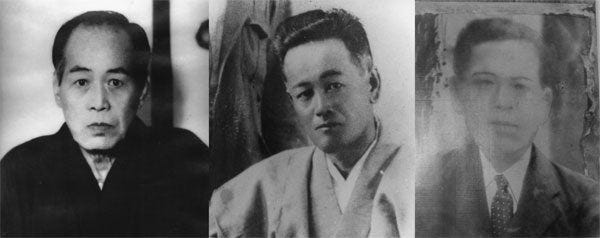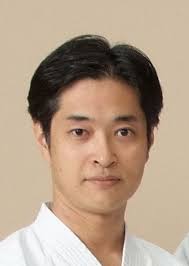From a lecture by Uehara Seikichi in

From Uehara Seikichi, “Talking about the secret martial art of the Ryukyu royal family,” April 4, 1992
Thank you for taking time out of your busy schedule today to listen to my talk. What I am about to tell you are some anecdotes I heard from Motobu Chōyū Sensei of the Motobu Udun and some of the techniques he taught me directly. This will be the first time I will be speaking in front of such a large number of people, and I’m sure there will be many things that you have not heard before.
Today’s theme is “Talking about the secret martial art of the Ryukyu royal family.” My Sensei was Motobu Chōyū Sensei of the Motobu Udun. He is the person in this photo, also know as Aji-ganashī-mē (按司加那志前, His Royal Highness) of the Motobu Udun.
Miyagi Chōjun Sensei and Kyan Chōtoku Sensei, who were famous at the time, also clearly referred to Motobu Chōyū Sensei as “Aji-ganashī-mē” (Your Highness).
Motobu Chōyū Sensei, or Aji-ganashī-mē, was a member of the royal family. After the king, the next to the king is udun — udun means the king’s brothers or children — these people [and their direct descendants] are called udun (literally palace).
The udun usually disappeared in three generations (by losing their royal status), but in the case of the Motobu Udun, they lasted eleven generations until the abolition of the Ryukyu Kingdom and the establishment of Okinawa Prefecture (1879). (note 1) In this sense, you can see how the Motobu Udun had a deep connection with the king. In the pamphlet we distributed, the genealogy of the successive kings and the Motobu Udun is described.
At the time I became a disciple of Aji-ganashī-mē, he was living in the town of Tsuji. Back then, Chōyū Sensei was about 60 years old. (note 2 ) When teaching, he often told me that (Motobu) Udundī was a royal martial art, and that since it was a martial art handed down only to the eldest son of the Motobu Udun, it should not be used in front of others, nor should it be shown to others. I had been told this constantly for ten years, ever since I became Chōyū Sensei’s disciple.
Furthermore, I had always been told that Udundī is only a tī (hand, art) used for (national) warfare, that the royal family has no tī used for private fights, and that the royal tī is only a tī used for warfare, so it should not be used in front of others under any circumstances [for private fight]. (note 3)
You may be wondering why Chōyū Sensei taught this Isshi Sōden (a martial art handed down only to the eldest son of the Motobu family) to me, who has no bloodline. As a matter of fact, Chōyū Sensei, or Aji-ganashī-mē, had three children (sons). His eldest son is Chōmei, his second son is Chōmo, and his third son is Chōshun.

The reason why I was able to learn this art from Chōyū Sensei was that these three sons had moved to the mainland [Japan] and none of them were in Okinawa; Chōyū Sensei was already old and even if he wanted to leave this art behind, he could not because his sons were not in Okinawa. Chōyū Sensei was in distress over this fact, and so in July, at twelve years of age, I became Sensei’s disciple.
Therefore, the art of Chōyū Sensei was not intended to have been passed to me as the only individual. Rather, it was intended to have been taught (through me) to his son, so that in turn, he could pass it on to the descendants in his lineage. In that sense, I was able to have been taught.
Note 1: Strictly speaking, if the successive heads of an udun did not have achievements and deeds, then the udun would lose its royal status in seven generations.
Note 2: The actual age of Motobu Choyū at the time was 52.
Note 3: An additional clause (1635) in the Buke shohatto (the Laws for the Military Houses, 1615) issued by the Tokugawa shogunate prohibited the daimyō (feudal lords) from engaging in private fights. Since Ryukyu was ruled by the Satsuma domain, Motobu Chōyu was probably mindful that private fights by the royal family could become an international problem.
In 1924, I finally visited Motobu Chōmo Sensei (1890–1945) in Wakayama to teach him the techniques I had learned from Chōyū Sensei. (note 1) The man in this photo is Chōmo Sensei. His nickname is Torajū (Tiger’s Tail). He was also known as Motobu’s Torajū Yacchī (Brother Trajū). Chōmo Sensei was also learning karate from Motobu Chōki Sensei back then. (note 2)

When I say Motobu Chōki [by his real name], you may not understand who I’m talking about, but if I call him Sārā Aji (Prince Monkey) or Motobu Zārū (Motobu’s Monkey), you’ll understand who I’m talking about. Sārā Aji is the third son of the Motobu Udun. Therefore, Chōyū Sensei is Motobu Chōki’s elder brother. Those are the brothers who were the true blood of the udun.
As I mentioned, in 1924, I taught Motobu Udundī to Motobu Chōmo (Torajū Yacchī) in Wakayama for six months. Since Chōmo Sensei had also studied karate with his uncle Chōki Sensei, his gōken (strong fist) was quite impressive. In addition, he was such a famous warrior that he was given the nickname “Torajū.” Torajū means that he was as agile as a tiger’s tail. He was very famous in Wakayama back then.
Since Chōmo Sensei was such a warrior, Chōyū Sensei gave me the following advice before I left to teach:
You are to meet Chōmo who is a tough guy, in a manner of speaking. You will not take it easy, but you will confront him with all your might as you would confront me. Punch and kick him as hard as you can. From Chōmo’s point of view, your level of skill is no match for him. Therefore, fight as you would against me.
With this advice, I went to Wakayama.

As I met with Chōmo Sensei, I handed him a letter from Chōyū Sensei. While reading the content, Chōmo Sensei asked me again and again, “Yā Yannā? Yā Yannā?” (Is it really you?) in the Okinawan dialect. [He looked wondering, “Are you really the person my father wrote to in this letter?”]. Because Chōmo Sensei is 17 years older than me, and I was only 20 at the time, and not very tall. Torajū Yacchī, on the other hand, as you can see in this photo, is very built.

Hence, he said to me, “Yā Yannā? Yā Yannā?” and I said, “Yes, that’s me.” I don’t know what the letter said, but he didn’t seem to take it seriously. So, finally, he said, “Well, stand up.” Then we both stood up. Then just as if to confront Chōyū Sensei, I struck him as hard as I could, and almost with one blow, his well-trained body staggered with the impact of my nukite’s fingertips. In fact, it was with this blow that Torajū Yacchī was surprised for the first time, and came to trust me.
Since Chōyū Sensei told me that I had to fight Chōmo Sensei as if I were confronting him, I had put all my hopes and effort into that single blow. As I said, he studied under his uncle, Chōki Sensei, and as a result, he had a well-trained body. Moreover, he was so talented that he was given the martial name of Torajū Yacchī. Thanks to these, he was able to master in just six months the techniques that I had practiced for ten years. In this way, the techniques Chōyu Sensei taught me, were specifically the ones he wanted to pass down in his bloodline.
Note 1: Motobu Chōyu decided that Motobu Udundī would be succeeded by his second son, Chōmo.
Note 2: Motobu Chōmo lived in Osaka before moving to Wakayama. When Motobu Chōki opened a karate dojo in Osaka, he was working as an assistant there.
The original English translation of the article was posted on June 5 and 12, 2020 on the Ameba blog.
Thank you for reading my story. If you would like, please follow me.
Written by:

Thank you for reading my story. If you would like, please follow me.
Shihan, Motobu Kenpō 7th dan, Motobu Udundī 7th dan. Discusses the history of karate and martial arts, and introduces Japanese culture and history.
